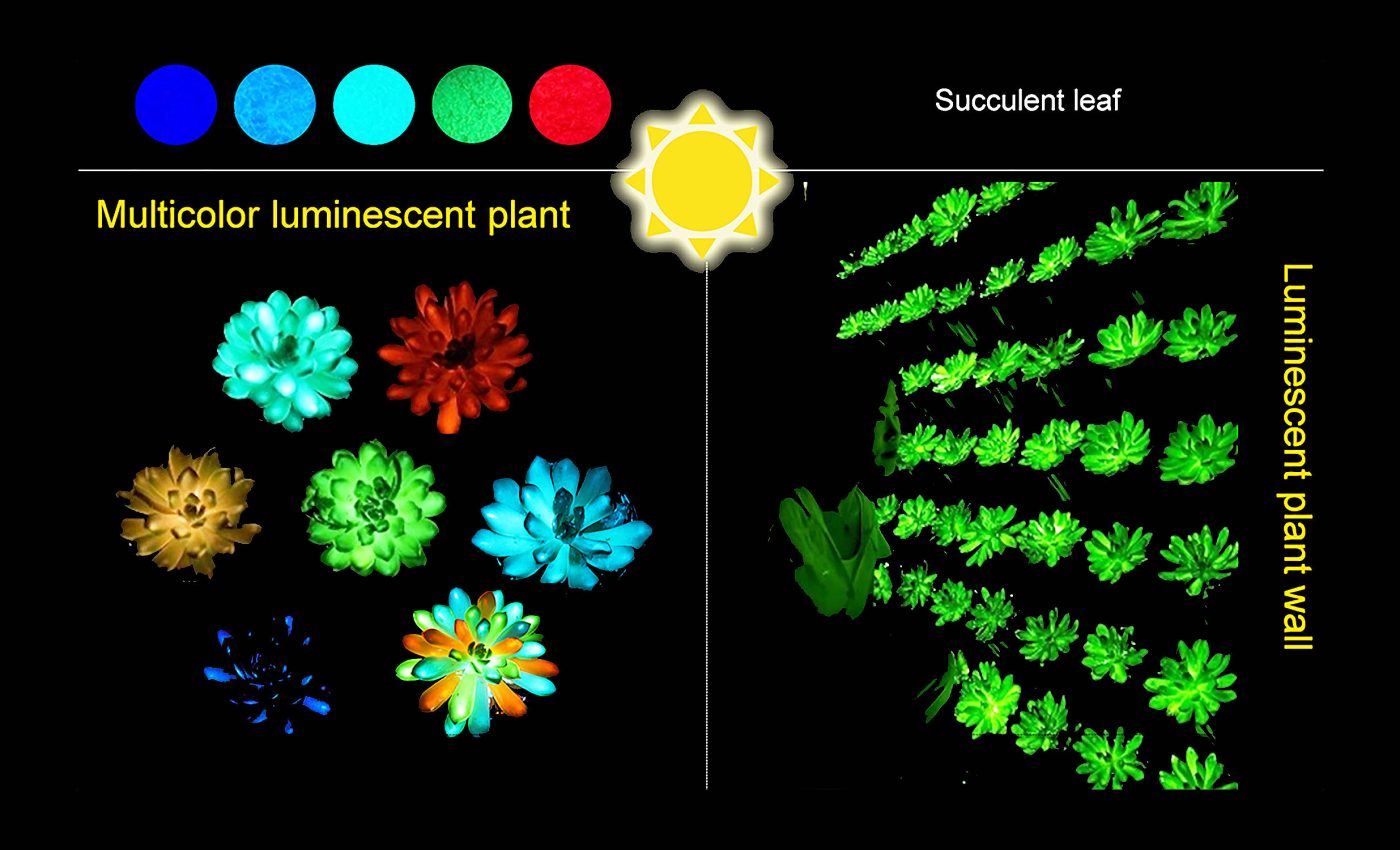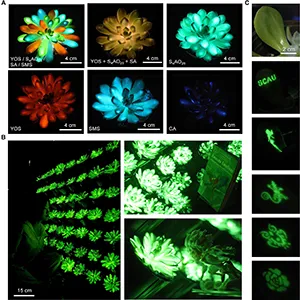
Scientists create plants that glow very brightly and 'recharge' in minutes
Imagine walking into a dark room where the plants themselves give off a bright, gentle glow – no batteries, no plugs, and no genetic tinkering. Scientists have turned this fiction into reality by transforming living succulents into light-powered “glow plants.”
A research team developed a method to slip tiny, light-storing crystals into the natural spaces between their leaf cells.
Those crystals “charge up” under sunlight or bright indoor light, then slowly release that energy as visible glow after the lights go off.
Because succulent leaves have a dense, uniform internal structure, the particles spread evenly and the whole plant lights up smoothly.
The researchers tested plant health, explored different glow colors (not just green), and showed that the plants can keep living normally while offering a reusable, battery-free source of soft illumination.
“Picture the world of Avatar, where glowing plants light up an entire ecosystem,” says first author Shuting Liu of South China Agricultural University.
“We wanted to make that vision possible using materials we already work with in the lab. Imagine glowing trees replacing streetlights.”
Making plants glow
The team relied on a familiar green phosphor: strontium aluminate doped with europium and dysprosium.
These crystals act like tiny energy traps. Light bumps electrons up; some settle into defects inside the crystal and get stuck. Room temperature nudges them free over time, releasing visible photons.
Because water can quench that glow, the particles were wrapped in a thin phosphate coating to keep them stable in the leaf’s watery environment.
Injecting crystals into leaves
Leaves are not solid slabs; they have microscopic corridors between cells. By making a pinprick injection into a succulent leaf, the researchers allowed a suspension of “glow beads” to flow through those corridors and settle outside the cells.
The particles didn’t enter cell interiors or clog the veins. That positioning lets the particles charge efficiently while the plant’s own machinery continues running.
Uniform leaf structure is the key to this trick. Certain succulents – especially Echeveria ‘Mebina’ – have tight, consistent internal spaces that guide particles evenly across the leaf.
In many non-succulent leaves, larger pockets encourage clumps near the injection site, causing blotchy bright spots instead of a smooth glow.
“Smaller, nanosized particles move easily within the plant but are dimmer,” says Liu. “Larger particles glow brighter but cannot travel far inside the plant.”
The sweet spot landed around a few micrometers across – on the order of four ten-thousandths of an inch – small enough to move, large enough to shine.
Charging and brightness
A brief charge under bright indoor LEDs or a short burst of direct sunlight is enough to produce a visible afterglow. The afterglow fades gradually – clearly visible in a dark room, like a screen that slowly dims.
If a plant is overexposed, it reaches a saturation point at which extra charging adds little additional brightness.
“It was really unexpected,” says Liu, noting that she initially thought plants with airy tissue structures would perform better. “The particles diffused in just seconds, and the entire succulent leaf glowed.”
Glowing plants stay healthy
The team didn’t stop at appearance. They measured chlorophyll, sugars, proteins, and catalase activity – a common stress marker.
At recommended doses, treated succulents held steady for days. Color and texture stayed normal.
Microscopy showed that tissues were intact, with particles parked outside cells rather than disturbing inner workings.

Not just green
Green is the brightest with strontium aluminate, but the approach is not limited to one hue. Blue, cyan, red, and blue-violet have been demonstrated using other long-lasting phosphors.
By mixing particles or assigning different colors to different leaves, the researchers created multicolor plants and even warm-white tones.
They also “wrote” with light. Flash ultraviolet light through a stencil for a moment, and only those areas charge extra.
When the lamp turns off, letters or logos appear for a couple of minutes before fading. It is a living, reusable, battery-free display.
Bringing glow plants into the world
Because this process is fairly simple and takes just minutes to replicate, you can expect to see glowing plants in public very soon.
The glow effect can also be scaled to many plants quite easily – enough for a small “plant wall” that can light up a face and a book in a dark room.
Don’t expect stadium-level brightness, but they are useful and quite stunning when used as accent lights, calming nightlights, emergency markers, museum exhibits, or quiet art that appears with the flip of a switch.
“I just find it incredible that an entirely human-made, microscale material can come together so seamlessly with the natural structure of a plant,” says Liu. “The way they integrate is almost magical. It creates a special kind of functionality.”
Plants already host helpful partners such as fungi and bacteria that extend their own inherent capabilities. Now, inorganic phosphors join that circle as guests that store light today and, with the right chemistry, might sense pollution or signal drought tomorrow.
The big takeaway is straightforward: work with a plant’s architecture, respect its biology, and you can add new functions without tearing anything down.
The full study was published in the journal Matter.
—–
Like what you read? Subscribe to our newsletter for engaging articles, exclusive content, and the latest updates.
Check us out on EarthSnap, a free app brought to you by Eric Ralls and Earth.com.
—–













